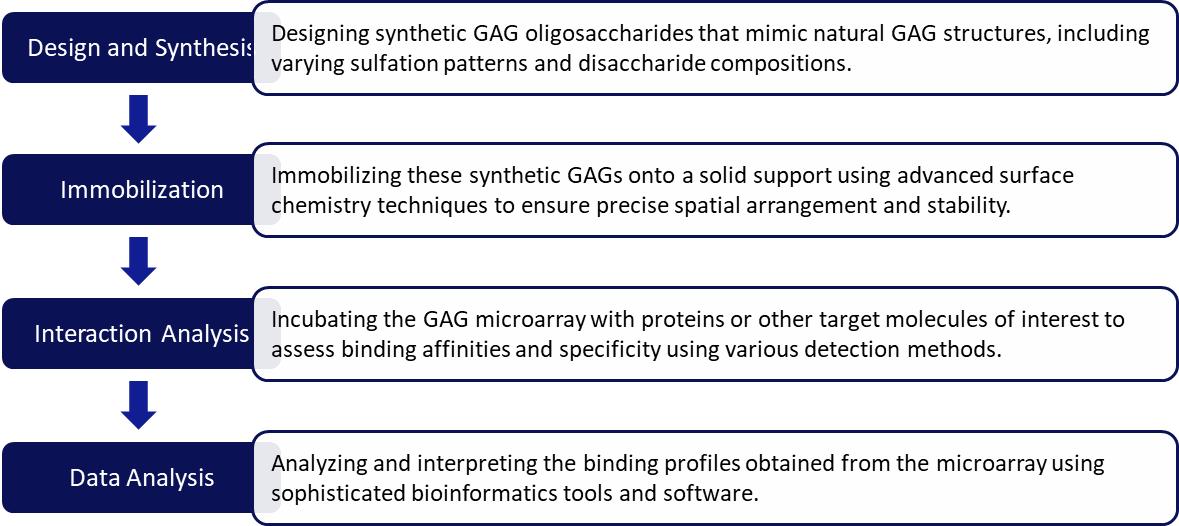What is Glycosaminoglycan Microarray?
Glycosaminoglycans (GAGs) are essential components of the extracellular matrix and cell surfaces, playing critical roles in various biological processes such as cell signaling, inflammation, and tissue regeneration. Their interactions with proteins are pivotal in regulating these processes. Glycosaminoglycan microarray technology represents a sophisticated approach to study these interactions comprehensively and efficiently.
Principle of Glycosaminoglycan Microarray
Glycosaminoglycan microarray operates on the principle of immobilizing synthetic GAG oligosaccharides onto a solid support, such as a glass slide or a chip, in a spatially defined array format. These synthetic oligosaccharides mimic the structural diversity and sulfation patterns found in natural GAGs. By immobilizing these molecules, researchers can systematically screen their interactions with proteins or other biomolecules in a high-throughput manner.
Glycosaminoglycan Microarray Assay Platform Offered by Creative Proteomics
Comprehensive GAG Screening: Conduct high-throughput screening of various glycosaminoglycans (GAGs), including heparin, heparan sulfate, chondroitin sulfate, dermatan sulfate, hyaluronan, and keratan sulfate.
Protein Interaction Studies: Investigate and characterize interactions between GAGs and proteins, elucidating binding affinities and kinetics.
Binding Specificity Analysis: Analyze the specificity of GAG-protein interactions to understand molecular recognition patterns.
Customized Microarray Design: Design tailored microarrays to meet specific research objectives, accommodating diverse experimental needs.
Bioinformatics Analysis: Utilize advanced bioinformatics tools for data interpretation and visualization, facilitating comprehensive analysis of experimental results.
Quality Control and Assurance: Ensure robustness and reproducibility of results through stringent quality control measures at every stage of the microarray workflow.
Advantages of Our Glycosaminoglycan Microarray Platform
- Rapid and high-throughput screening: The microarray format allows for the rapid, simultaneous detection of multiple protein-GAG binding events using minimal amounts of carbohydrate and protein.
- Defined sulfation patterns: The microarrays can be constructed using chemically synthesized GAG oligosaccharides with defined sulfation patterns, enabling the study of the importance of specific sulfation motifs in protein binding.
- Versatility: The platform can be used to screen a wide range of proteins, including growth factors, cell-surface receptors, and chemokines, for binding to different GAG subclasses (e.g. chondroitin sulfate, heparan sulfate, heparin).
- Sensitivity: The microarrays are highly sensitive and can detect even weak protein-GAG interactions (e.g. KD > 10 μM).
- Simplicity: The microarray preparation method is relatively simple, using commercially available GAGs and a straightforward adsorption-based immobilization approach, without requiring specialized expertise in carbohydrate or surface chemistry.
- Reproducibility: The microarray methodology provides reproducible and consistent results, enabling reliable comparisons of protein binding specificities across different GAG classes.

Sample Requirements for Glycosaminoglycan Microarray
| Sample Type | Recommended Quantity | Description |
|---|---|---|
| Protein Solutions | 1-10 μg per microarray | Purified proteins in compatible buffers for immobilization and interaction studies. |
| GAG Solutions | 0.1-1 μg per microarray | Synthetic or purified natural GAGs dissolved in appropriate solvents for immobilization. |
| Serum or Cell Lysates | 10-100 μg per microarray | Complex biological samples containing endogenous GAGs and proteins, prepared and diluted. |
Buffers: As required. Use of PBS, TBS, or other compatible buffers with additives like BSA for experimental conditions.
Storage Conditions: -20°C or 4°C. Recommended storage temperatures to maintain sample integrity and stability.
Applications of Glycosaminoglycan Microarray
Protein-GAG Interaction Profiling:
- Biological Signaling: Investigate how GAGs modulate signaling pathways involved in cellular communication and development.
- Disease Mechanisms: Study the role of GAG-protein interactions in disease progression, including cancer metastasis, inflammation, and neurodegenerative disorders.
Drug Discovery and Development:
- Target Identification: Screen and identify potential drug targets by assessing the binding affinities of GAGs with therapeutic proteins or receptors.
- Therapeutic Optimization: Optimize drug candidates by understanding their interactions with endogenous GAGs, enhancing efficacy and minimizing off-target effects.
Biomedical Diagnostics:
- Biomarker Discovery: Identify novel biomarkers associated with disease states through profiling of GAG-protein interactions in clinical samples.
- Diagnostic Assays: Develop diagnostic assays based on specific GAG-protein binding profiles for early disease detection and monitoring.
Glycoengineering and Vaccine Development:
- Glycoprotein Engineering: Engineer glycoproteins with enhanced therapeutic properties by optimizing their interactions with GAGs.
- Vaccine Design: Design glycoprotein-based vaccines that mimic pathogen-associated GAG interactions, eliciting targeted immune responses.
Regenerative Medicine and Tissue Engineering:
- Tissue-Specific Interactions: Study how GAGs influence cellular adhesion and differentiation in tissue regeneration and engineering applications.
- Implant Integration: Assess the compatibility of biomaterials with host tissues based on their GAG-binding profiles, improving implant success rates.
Personalized Medicine:
- Patient-Specific Profiles: Customize treatment strategies based on individual variations in GAG-protein interactions, optimizing therapeutic outcomes.
- Precision Medicine: Tailor therapies to target specific molecular pathways influenced by GAG-mediated protein interactions, improving treatment efficacy and patient outcomes.
Immunology and Infectious Diseases:
- Pathogen Interactions: Study how pathogens interact with host GAGs to invade cells and evade immune responses, informing strategies for infection control and vaccine development.
- Inflammatory Responses: Investigate the role of GAGs in regulating immune cell activation and cytokine signaling during inflammatory processes.




